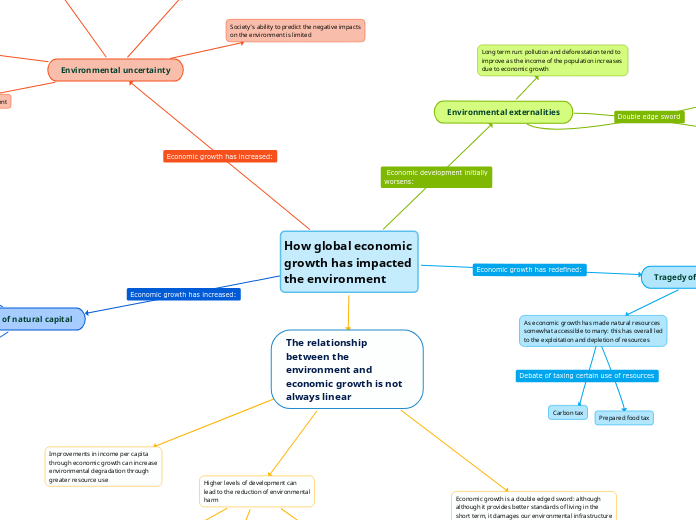How global economic growth has impacted the environment
Loss of natural capital
Decrease in ecosystem services
The food we eat
The water we drink
Plant materials used for fuel
Th
Driving emission rates and in turn
driving climate change
Depletion of natural capital
and ecosystem services
Average surface temperature
precipitation patterns
Oxygen content
Temperature and acidity of water bodies
Environmental uncertainty
Loss of biodiversity
Humans have transformed the majority
of the Earth's ecosystems
Terrestrial, marine, and aquatic habitats
Natural forests declined by 6.5 million hectares per year from
2010 to 2015
mangroves declined by
20% from 1980 to 2005
wetlands declined by 35% between 1970 and 2015
This relates back to the discussion post from week 1, where we were asked to discuss what qualifies as a resource: anything a human can transform to fill a demand (this is the anthropocentric view)
Soil erosion
Increasing demand
for food
It is estimated that by 2050 agricultural production will have to rise by 70% to meet the needs of growing world population
Large scale
land degradation
Global warming and air pollution
2010: after the recession there was
once again an annual gain in gas
emissions due to the economy
rebounding
2018: once again an annual gain in
gas emissions to due aggregate economic growth driven by by a higher demand for energy, trucking and air travel, and industrial activity
Long-term toxins in the environment
Economic growth has led to the
increased consumption of plastic:
plastic is not degradable, this leads
to an ever-increasing stock of plastic
in the land and water
Society's ability to predict the negative impacts
on the environment is limited
The relationship between the environment and economic growth is not always linear
Improvements in income per capita
through economic growth can increase
environmental degradation through
greater resource use
Higher levels of development can
lead to the reduction of environmental
harm
Technological advancement
Improved government policies
Increased demand for environmental protection
Corporations taking a more sustainable approach to operations
Economic growth is a double edged sword: although
although it provides better standards of living in the
short term, it damages our environmental infrastructure
in the long term
A huge fraction of the global population still
do not have the resources to meet their most
basic needs
Tragedy of the commons
As economic growth has made natural resources
somewhat accessible to many: this has overall led
to the exploitation and depletion of resources
Carbon tax
Prepared food tax
Fast fashion
Corporations take advantage of
Perceived obsolesce and create
and sell products that they know
consumers will dispose of as soon
as the trend ends
Overproduction by fashion brands
leads to an unnecessary disposal of
resources
Burberry burnt $37.8 million worth of its 2018 season's leftovers to avoid offering a discount on unsold merchandise
Groundwater use in the US
Groundwater is a viable drinking source
for roughly half of the US's population, in
addition 50 billion gallons of groundwater
is used per day for agriculture
Due to this, groundwater is being depleted
faster than it can be replenished
Environmental externalities
Long term run: pollution and deforestation tend to
improve as the income of the population increases
due to economic growth
The more wealthier people become the more they demand and get improved environmental quality through regulation and market mechanisms that drive sustainable and less resource-intensive processes and technologies
As income increases driving economic growth forward
this also means there is an increase in consumption and
production, leading to more pollution
